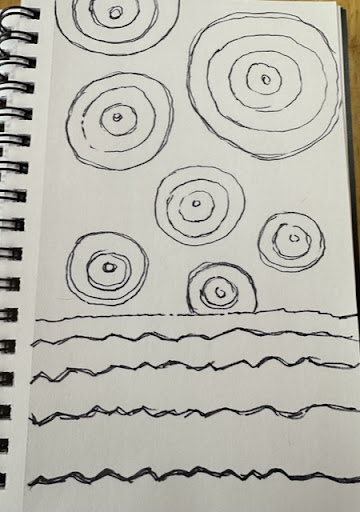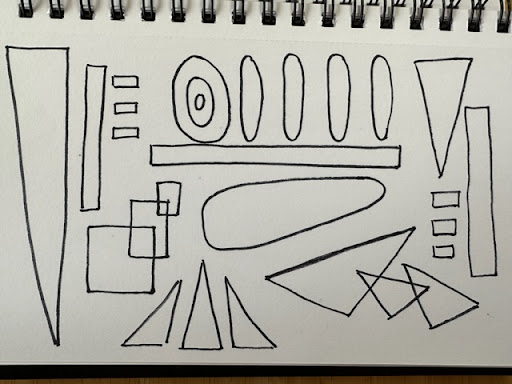
30 Mar Art Journaling for Mindfulness Part 3: Creating Calmness
By Barbara K. Stump, MA
What are some activities you do to relieve stress, relax, and bring a sense of calmness into your life? Personally, I like to get outside and enjoy nature. However, living up in northern Michigan, the weather does not always cooperate. So, I recently joined a gym and started doing yoga once a week. I’m a newbie to yoga, and trying something not in one’s comfort zone can be a little awkward. Surprisingly, I’m finding it to be a peaceful way to end the week. Another stress reliever for me, besides yoga, is music. I like a wide variety of music from country, classic rock, to pop, and R&B. Although, every once in a while I will listen to classical music. I find it to be soothing, and it allows me the ability to focus on other things without getting caught up in the lyrics. In Part 3 of Art Journaling for Mindfulness, I would like to share the idea of using classical music to create art.
When was the last time you listened to classical music? Where were you? What did you think? Did you find it relaxing? Is it something you might not have given a chance before, but could look at this prompt as an opportunity to try it again? Perhaps this might be encouraging, I have been told by music teachers that listening to classical music can have many mental health benefits. Here are some of the benefits they shared:
- It’s calming
- It combats depression
- It relieves stress
- It improves focus
- It is relaxing
To further back these claims, Dr. David Lewis-Hodgson, of Mindlab International, concludes: “If you want your mind and body to last, you’ve got to prioritize giving them a rest. Music is an easy way to take some of the pressure off of all the pings, dings, apps, tags, texts, emails, appointments, meetings, and deadlines that can easily spike your stress level and leave you feeling drained and anxious.”
Considering all of these positive reasons to use music to improve your life, hopefully this week’s prompt might be worth a try! So, to help ease your comfort level for this art journaling idea, the intention is for you to create abstract art with music as your inspiration. Abstract art is non-representational; it is not realistic. You, as the artist, will use lines, shapes, and colors to create your compositions in your sketchbooks. This is meant to allow you to focus on the movements in the music, your reaction to these, and to mimic the movements in your own artwork.
Before doing this in your art journal, maybe Google the artwork of one of my favorite abstract artists, Wassily Kandinsky. This famous artist would use various types of lines, shapes, and colors to create his engaging, and sometimes whimsical, paintings.
So, give yourself permission to let go of trying to make something look realistic. Try to remain in the present and experience the movements of the music. Do this by using a black sharpie to reflect your vision of the music while listening to each composition. Think about how you would visually interpret the music. As you are creating, ask yourself what types of lines and shapes would reflect the way the music sounds? Select any classical music you would like to explore!
Below are a few examples of reflections I did while listening to: “Nocturne Op.9, No. 2” by Frederic Chopin; “Piano Concerto No. 21” by Wolfgang Amadeus Mozart; and “Dance of the Sugar Plum Fairy” by Pyotr IIyich Tchiakovskey.



Since some classical music compositions are very long, it is ok to limit the time you spend listening to a given piece. Choose as many pieces as you would like to sample and experiment with in your journal. When finished with a composition, write on the back of each journal entry what colors came to mind as you listened to that piece. For example cool colors of blues, violets and greens, or warm colors of yellow, orange, and red. Then you could go back on another day and add color with whatever medium you would like, such as watercolor, markers, pastels, or acrylic paint. Below are a few examples of classical music studies some of my high school students made after we did this exercise in class.


I hope you find this musical prompt enjoyable. Remember there really is no wrong way to use your art journal. So, if this prompt leads you down a different path, and you find it relaxing, then go with it! Wouldn’t it be nice to end your day, or week, with a sense of calmness? The benefits of listening to classical music are definitely a reason to give it a try. Hopefully through these journal entries you might open your mind to a new way to relieve stress while creating art. For another alternative, if you like rock, at least give Queen’s “Bohemian Rhapsody” a listen as you create! Why not?! If it makes you happy then even better. As my yoga instructor says at the end of class, “Shanti…peace, peace, peace.”

Barbara is an art education consultant and G3 contributing writer.

